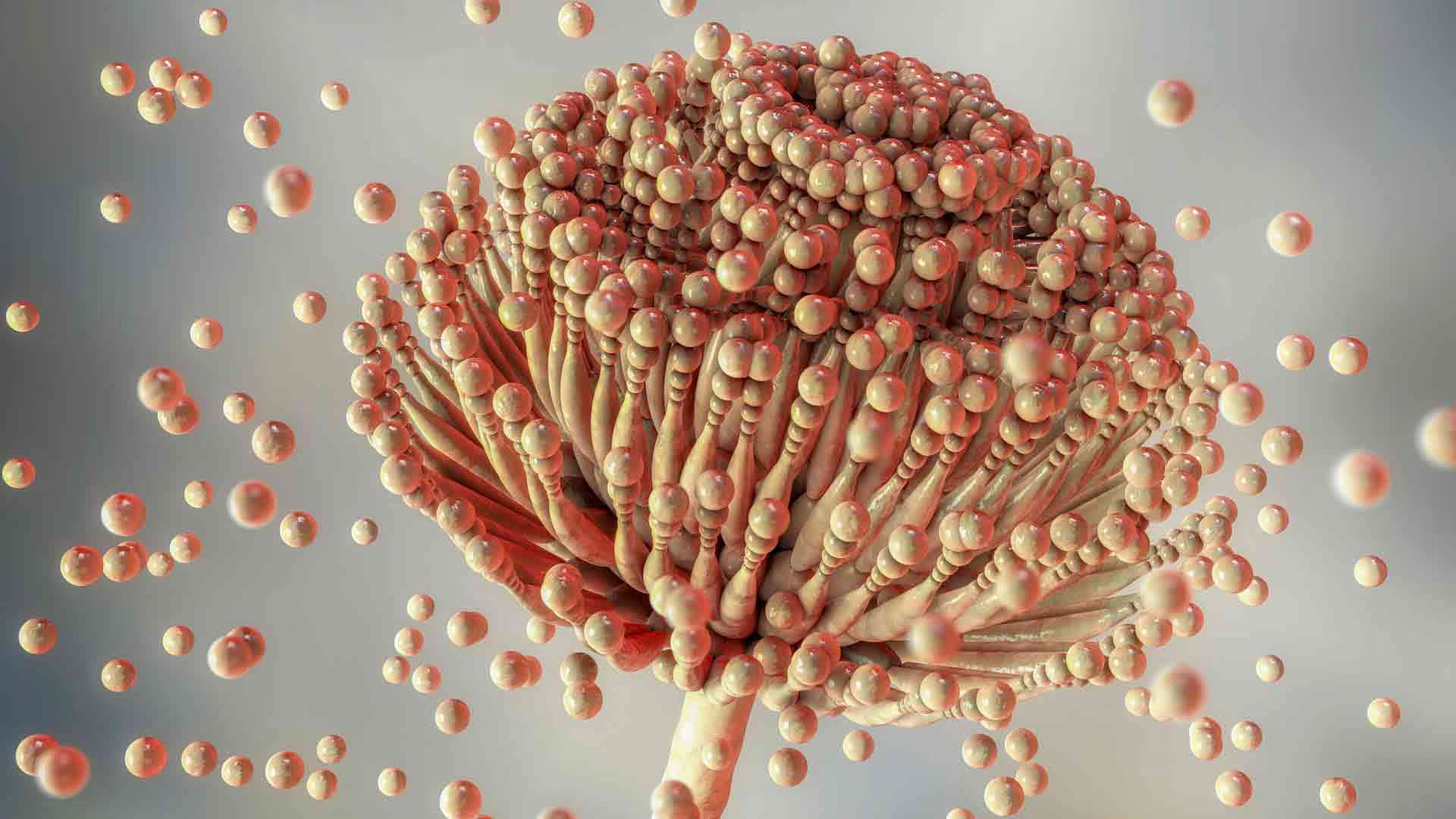Abstract
Extremophiles — organisms thriving in extreme environments — challenge our understanding of how life thrives and adapts. These organisms exhibit remarkable diversity and unique biochemical adaptations, such as extremozymes and stress-resistant cellular mechanisms. Extremophiles have evolved biochemical pathways to produce bioactive compounds with incredible stability and bioactivity. These extremophilic metabolites, including antimicrobial peptides, extremozymes, anticancer agents, antioxidants, and beyond, hold immense potential for applications across numerous industries including pharmaceutics, biotechnologies, bioremediation, agriculture, biofuel production, and more. Recent advances in genomics, metagenomics, and synthetic biology have accelerated the discovery of novel bioactive compounds from these resilient organisms, offering innovative solutions to global challenges such as antibiotic resistance, industrial catalysis, and environmental sustainability.
Introduction: What are extremophiles?
Life on Earth exhibits an astonishing capacity to adapt to even the most inhospitable environments. Organisms known as extremophiles thrive in conditions that were once considered incompatible with life, including scorching hydrothermal vents, highly acidic or alkaline lakes, hypersaline waters, and the frozen deserts of Antarctica. The study of these resilient microorganisms has revolutionized our understanding of the boundaries of life, offering critical insights into evolutionary biology, biotechnology, and even astrobiology.
Extremophiles are classified based on the extreme conditions they inhabit. They include thermophiles (high temperatures), psychrophiles (freezing temperatures), acidophiles and alkaliphiles (extreme pH), halophiles (high salinity), barophiles (high pressure), and xerophiles (extreme dryness), among others. Their survival strategies often involve specialized enzymes known as extremozymes, unique biomembrane structures, DNA repair mechanisms, and metabolic pathways that allow them to withstand extreme physicochemical stresses.
The discovery of extremophiles has already made profound impacts. In biotechnology, the extremozyme Taq polymerase, derived from the thermophile Thermus aquaticus, revolutionized PCR technology, while enzymes from halophiles and alkaliphiles are used in detergents, food processing, and waste treatment. Additionally, extremophiles play a crucial role in bioremediation, breaking down pollutants in extreme environments where conventional microbes fail.
From an astrobiological perspective, extremophiles serve as analogs for potential extraterrestrial life. Subsurface methanogens in permafrost, sulfur-metabolizing archaea in hydrothermal vents, and radiation-resistant bacteria provide clues about how life might persist on celestial bodies like Mars, Europa, or Enceladus. The study of extremophiles thus bridges the gap between Earth's biology and the search for life beyond our planet.
Despite their significance, however, many aspects of extremophile biology remain unexplored. How do they evolve under extreme barometric pressures? What undiscovered species lurk in Earth's most remote ecological niches? Can their unique biochemistry be further harnessed for sustainable technologies? Innovative solutions such as metagenomic mining of unculturable species, heterologous expression in model hosts, and nanotechnology-assisted delivery systems are helping solve these essential questions.
In this report, we explore data from the CAS Content Collection™, the largest human-curated repository of scientific information, to better understand research progress in the field of extremophiles. From the ocean's depths to nuclear exclusion zones, these tiny organisms are driving innovative approaches to scientific challenges spanning drug discovery, environmental remediation, and much more.
Types of extremophiles and how they survive
The term "extremophile" was invented by MacElroy in 1974 for organisms that can live in extreme environments. While containing some protozoal, algal, and fungal species, most extremophiles are prokaryotic, classified within the domains Archaea and Bacteria, with unique metabolic and physiological adaptations that allow them to survive in these harsh environments.
As noted, extremophiles live in incredibly hot or cold environments, in those of high salinity or extreme pH, and in extremely high-pressure environments, such as deep marine trenches. There are also extremophiles with radiation resistance that can survive in deserts and nuclear sites. For example, Cladosporium chernobylensis, a fungus from Chernobyl's Exclusion Zone, exhibits diverse survival strategies such as DNA repair and melanin production. As shown in Table 1, the variety of extremophiles spans many inhospitable environments:
Extremophiles exhibit extraordinary survival mechanisms that enable them to colonize Earth’s most inhospitable environments. These microorganisms have evolved sophisticated biochemical, structural, and genomic adaptations to withstand extreme temperatures, pH fluctuations, high salinity, desiccation, and radiation. Some of their key survival mechanisms include:
Recent discoveries of new extremophiles
Recent advances in microbial ecology and genomics have significantly expanded our understanding of extremophile diversity, revealing novel taxa and previously unexplored adaptive strategies in extreme environments. High-throughput sequencing and single-cell genomics have uncovered cryptic lineages within archaea and bacteria inhabiting hydrothermal vents, hyperacidic lakes, polar ice sheets, and deep subsurface biospheres. Metagenomic studies of extremophile communities have identified unique metabolic pathways, such as novel chemolithotrophic mechanisms in deep-sea thermophiles and hybrid photosynthetic systems in halophilic archaea.
The discovery of Asgard archaea in hot springs has proven interesting, providing new insights into eukaryotic evolution and the isolation of radiation-resistant bacteria from nuclear waste sites with unprecedented DNA repair capabilities. Scientists also discovered a new type II L-asparaginase from a halotolerant Bacillus subtilis CH11 strain, isolated from Peruvian salt flats. Developing L-asparaginase variants with increased stability and efficiency is a crucial goal due to the widespread use of this enzyme in the food industry and in cancer treatment.
Distinct prokaryotic communities have been recently reported from caves, with specialized taxa adapting to localized energy and nutrient conditions. A new species, Pseudocandona movilaensis, has been discovered in the sulfidic waters of the Movile Cave in Romania, with a unique chemoautotrophic ecosystem where life is supported by the oxidation of hydrogen sulphide instead of photosynthesis. Also, extremophilic bacteria, particularly halophiles, have developed in disused copper mines.
Bacterial extremophiles, specifically the Candidate Phyla Radiation (CPR) bacteria, are a fascinating group of microorganisms, particularly those recently found in acidic mine drainage environments. They are characterized by their ultra-small size, reduced genomes, and dependency on interactions with host organisms.
Deinococcus radiodurans and its relatives, like others in the Deinococcaceae family, are known for their extraordinary radiation resistance, particularly in environments with high levels of ionizing radiation, such as within or near nuclear reactors. They have developed efficient systems to repair DNA damage caused by radiation and other stresses like desiccation.
Additionally, culture-independent techniques have revealed "microbial dark matter" in extreme environments, suggesting a reservoir of untapped phylogenetic and functional diversity. These discoveries not only redefine the boundaries of life on Earth but have profound implications for astrobiology, biotechnology, and climate change resilience.
However, challenges remain in cultivating these organisms and translating genomic insights into functional understanding. Future research should integrate multi-omics approaches with advanced cultivation methods to explore the ecological roles and biotechnological potential of these newly discovered extremophiles.
Bioactive compounds from extremophiles
Extremophiles produce unique bioactive compounds with potential applications in medicine, industry, and biotechnology (see Table 2). These secondary metabolites — including enzymes, antimicrobial agents, and antioxidants — exhibit remarkable stability and functionality under harsh conditions. Recent advances in extremophile bioprospecting have uncovered novel compounds with therapeutic properties, including anticancer, anti-inflammatory, and antimicrobial activities. Additionally, extremophile-derived enzymes (extremozymes) are valuable in industrial processes due to their robustness under extreme pH, temperature, and salinity. These compounds offer novel solutions to challenges in drug resistance, industrial catalysis, and environmental sustainability.
Recent studies have revealed that over 40% of microbial bioactive compounds remain undiscovered, with extremophiles representing a major untapped resource. CRISPR-Cas systems (derived from Streptococcus thermophilus) and Taq polymerase (from Thermus aquaticus) are among the most successful extremophile-derived biotechnological tools. Halophiles, thermophiles, and acidophiles produce antimicrobials, anticancer agents, and biodegradable polymers with industrial relevance.
Advances in various -omics technologies and bioinformatics have unveiled many previously unknown secondary metabolites, peptides, and extremozymes that exhibit remarkable bioactivity under extreme conditions. These extremozymes and secondary metabolites offer advantages over conventional drugs, including thermostability (useful for storage and delivery), novel structures (bypassing existing resistance mechanisms), and high specificity (reducing off-target effects).
Groundbreaking discoveries include:
- Hyperthermostable antimicrobial peptides from deep-sea thermophiles that disrupt bacterial membranes through novel pore-forming mechanisms.
- Radiation-resistant pigments from Deinococcus species that exhibit potent antioxidant activity via unique free radical scavenging pathways.
- Acid-stable antibiotics from Sulfolobus with modified thioether bridges that target drug-resistant pathogens through dual mechanisms of cell wall inhibition and membrane depolarization.
The structural adaptations that confer bioactivity under extremes are notable, such as D-amino acid incorporation in halophilic bacteriocins, pressure-resistant folding in piezophilic compounds, and cryoprotective modifications in psychrophilic metabolites. The molecular targets of these compounds are also noteworthy, including their interactions with microbial membranes (e.g., lipid II binding by thermophilic lipopeptides), inhibition of essential enzymes (e.g., proteasome inhibition by deep-sea derived salinosporamides), and interference with nucleic acid metabolism (e.g., DNA intercalation by radioresistant bacterial metabolites).
Innovative discovery approaches have revolutionized extremophile bioprospecting, including meta-omics guided genome mining, heterologous expression in synthetic biology platforms, and high-throughput activity screening under simulated extreme conditions. These novel approaches have resulted in translational applications in medicine, such as next-generation antibiotics targeting multidrug-resistant ESKAPE pathogens. In agriculture, extremolyte-based biostimulants have been identified, and solvent-stable enzymes for green chemistry are changing industrial biotechnology.
Researchers are addressing challenges in compound scalability and structure-activity optimization with proposed solutions by leveraging computational modeling and CRISPR-based pathway engineering. This synthesis of extremophile bioactive discovery and mechanistic understanding provides a roadmap for future research and foundation for developing innovative solutions to global health and environmental challenges.
Table 3 shows available drugs/active agents derived from extremophiles and their applications. These include FDA-approved examples such as L-asparaginase and Taq polymerase; promising preclinical candidates such as Halocins that fight antibiotic resistance; and Bacterioruberin, which is useful in cancer treatment.
Despite their potential, challenges in cultivation and extraction persist. Many extremophiles are still difficult to culture, and more clinical trials are needed. Future research should leverage metagenomics and synthetic biology to harness these bioactive molecules efficiently.
Still, the unique evolutionary pressures on extremophiles have yielded bioactive compounds with unparalleled properties and novel mechanisms of action. As discovery technologies advance, these organisms will play a vital role in addressing global health and environmental challenges. Systematic investigation of their bioactive compounds not only expands our pharmacological arsenal but also provides fundamental insights into life's adaptability.
Research landscape and new breakthroughs
Our analysis of the CAS Content Collection revealed the number of extremophile-related documents has tripled in the last 25 years. The number of patents is relatively low at about 5% of the overall documents, but the yearly number of patents has increased four times since the year 2000 (see Figure 1).
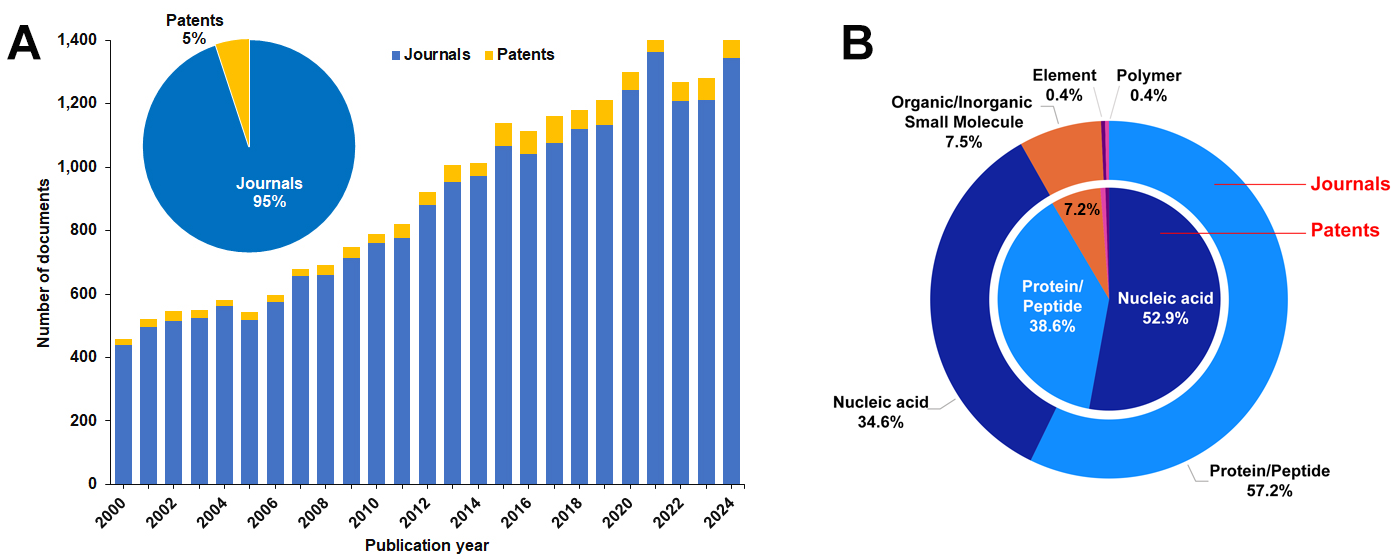
Our analysis indicates that proteins/peptides and nucleic acids are most associated with extremophiles. In patents, nucleic acids represent less than 50%, while in journals proteins/peptides dominate, with about 60% of publications. Small molecules are represented in about 8% of the documents (see Figure 1B).
We also examined the distribution of extremophile types in the related literature (see Figure 2).
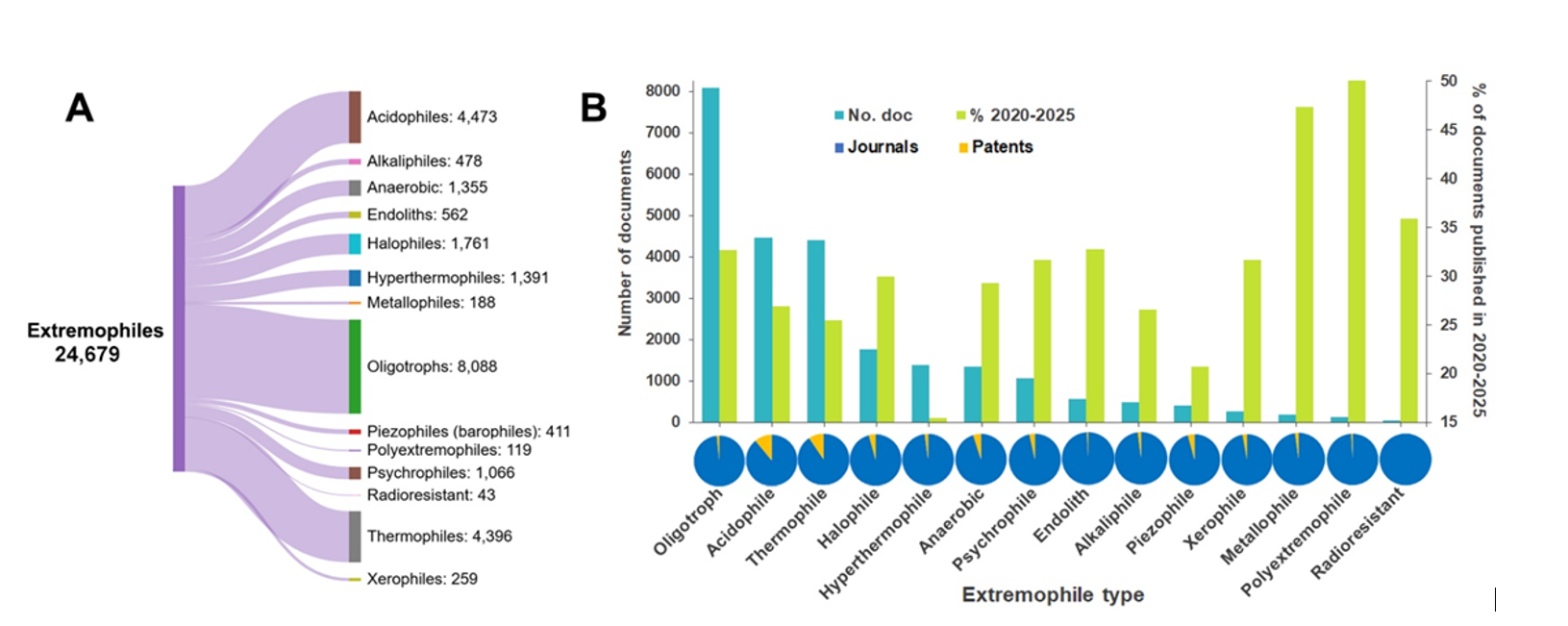
From these analyses, we found a number of significant takeaways:
The largest number of extremophile-related documents is related to oligotrophs, organisms that thrive in nutrient-poor environments
Oligotrophic environments, such as open oceans, the deep subsurface, and deserts, cover most of Earth. Hence, oligotrophs drive key processes like carbon sequestration in nutrient-poor oceans, nitrogen and phosphorus cycling in barren soils, and microbial diversity maintenance in extreme ecosystems. Their ability to thrive on minimal resources makes them valuable for bioremediation, bioenergy (e.g., microbial fuel cells with minimal substrate needs), as well as novel enzymes and bioactive compounds that are adapted to extreme scarcity. As nutrient-poor environments expand due to climate change, understanding oligotrophs helps predict microbial responses to ecosystem changes and carbon storage shifts in warming oceans.
Furthermore, oligotrophs survive in conditions resembling those on Mars, Europa, or Enceladus, where nutrients are scarce. Studying them helps identify potential extraterrestrial life, develop life-detection strategies for space missions, and understand survival mechanisms in these environments. Early Earth had limited nutrients, making oligotrophs possible analogs for ancient life. Their study provides clues about how primordial microorganisms adapted and the origins of metabolic pathways in low-nutrient conditions.
The extremophiles exhibiting the largest growth in publications in the last five years are the polyextremophiles (~51%), metalophiles (~47%), and radiophiles (~36%)
- Polyextremophiles — organisms that thrive under multiple extreme conditions simultaneously — have recently surged in scientific interest because they push the boundaries of life’s limits and offer unparalleled insights into biology, astrobiology, and biotechnology. Polyextremophiles produce multifunctional enzymes and biomolecules stable under extreme industrial conditions. As Earth faces rising temperatures, ocean acidification, and desertification, polyextremophiles help predict microbial resilience in collapsing ecosystems, carbon cycling in thawing permafrost, and evolution under rapid environmental shifts.
- Metallophiles are microorganisms that thrive in environments with high concentrations of toxic metals (e.g., arsenic, mercury, cadmium, uranium). They play a critical role in cleaning up contaminated sites like mine tailings and industrial waste, nuclear waste sites, and mercury- and arsenic-laden water. Their ability to immobilize or transform toxic metals offers a low-cost, eco-friendly alternative to chemical cleanup. Metallophiles are also key players in biomining, where they extract valuable metals such as copper, gold, and rare earth elements from low-grade ores, which reduces the need for toxic chemicals like cyanide in mining. Metallophiles produce unique biomolecules to survive metal toxicity, including metal-binding peptides and siderophores that could provide sources of new antibiotics. They contain enzymes that detoxify heavy metals that could be useful in chemotherapy drug development, and they have radiation-resistant compounds. No other extremophiles interact with toxic metals as intimately, making them essential for environmental, industrial, and astrobiological breakthroughs.
- Radiophiles thrive in high-radiation environments, such as nuclear waste sites, cosmic rays in space, or radioactive mineral deposits. Radiophiles like Deinococcus radiodurans survive thousands of times the lethal human radiation dose due to ultra-efficient DNA repair enzymes. These could unlock new cancer treatments, protective antioxidants, and DNA repair mechanisms. Radiophiles are also being engineered to clean up radioactive contamination: Geobacter sulfurreducens reduces uranium, making it less soluble in groundwater; Rubrobacter radiotolerans survives in nuclear reactor coolant, breaking down toxic isotopes; and researchers are attempting to create "super-radiophiles" for Chernobyl/Fukushima-style cleanup.
The extremophiles with the largest percentage of patents are acidophiles (~11%) and thermophiles (~9%)
- Acidophiles: These microorganisms are crucial for metal extraction, acid mine drainage remediation, and recovering rare earth elements (e.g., from discarded smartphones and batteries). This makes them key players in sustainable mining and circular economy strategies. Acidophiles produce acid-tolerant enzymes with uses in biofuel production (cellulases, xylanases that work at low pH), the food industry, and pharmaceuticals, such as the discovery of novel antibiotics from acidic hot springs. Their enzymes often outperform conventional ones in harsh industrial conditions. Their study bridges microbiology, astrobiology, industry, and environmental science, making them one of today’s most impactful extremophile groups.
- Thermophiles — organisms that thrive at high temperatures (typically 45–80°C) and hyperthermophiles (growing best at 80°C and above) — have become a major focus in extremophile research due to their unique biology and industrial applications. They produce heat-resistant extremozymes that remain functional at high temperatures. This has made them invaluable for PCR (Polymerase Chain Reaction). As noted, Taq polymerase from Thermus aquaticus revolutionized DNA amplification. They also have important medical and pharmaceutical applications such as heat-stable enzymes used in diagnostics and drug synthesis. Thermophiles produce novel antimicrobial compounds that aid in antibiotic discovery, and they are also vital for cancer research, since the study of heat shock proteins (HSPs) in thermophiles aids in understanding cellular stress responses.
In renewable energy and waste treatment research, thermophiles are involved in biofuel and biohydrogen production, biogas enhancement, and extreme bioremediation. Heat-stable enzymes improve brewing, baking, and dairy production in the food industry, and thermophilic proteases and lipases enhance stain removal in hot washes for better detergents. With their varied applications, it’s understandable why thermophiles are found in patent literature and commercial uses.
We analyzed the CAS Content Collection to better understand growth trends in research specifically relating to extremozymes and biomolecules (see Figure 3):
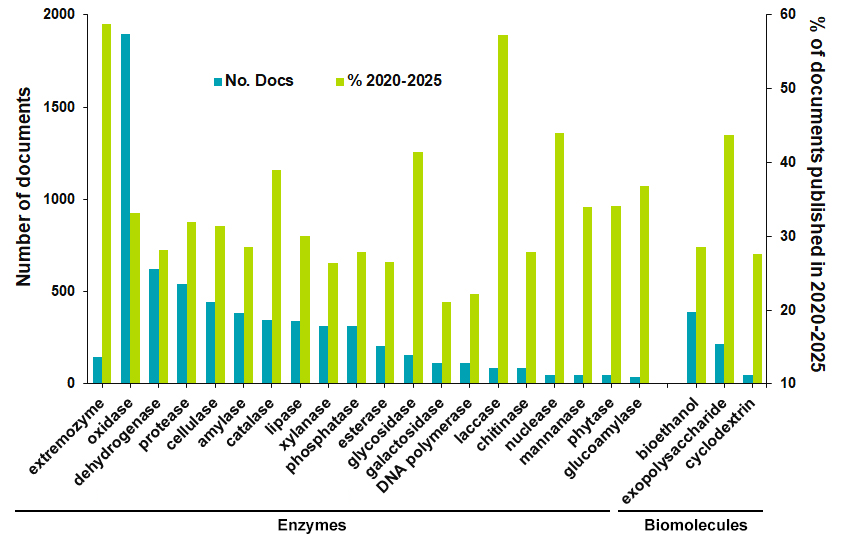
Figure 4 shows a heat map of the relative co-occurrences of extremophiles belonging to various classes with the types of produced extremozymes:
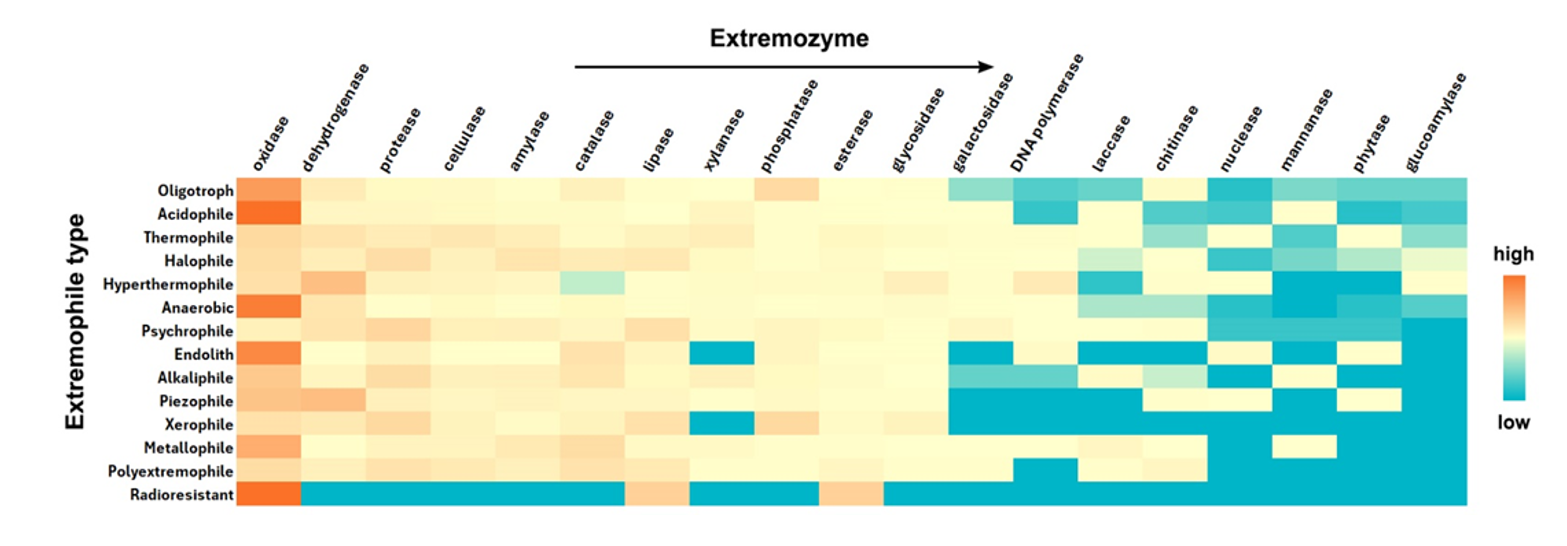
Oxidases are the enzymes with the highest number of extremophile-related documents
Oxidases are among the most studied extremozymes due to their ecological significance, industrial applications, and unique adaptations to extreme conditions. Many extremophiles (e.g., thermophiles, alkaliphiles, and halophiles) rely on oxidases for respiration in oxygen-limited or extreme environments. Also, some oxidases help extremophiles cope with oxidative stress in harsh conditions. Their thermostability is key — oxidases from thermophilic bacteria remain active at high temperatures, which is useful in biofuel production, food processing, and waste treatment. Their tolerance to extreme pH, salinity, and solvents is also important in harsh industrial processes.
Extremophile oxidases often have modified protein structures, such as enhanced ionic bonds in halophiles or compact folds in thermophiles, that make them robust. Studying these adaptations helps in enzyme engineering for applications from bioremediation to medicine.
Extremophilic laccases, nucleases, glycosidases, and catalases exhibit the highest growth trend
Extremophilic laccases exhibit unique stability in harsh industrial conditions, outperforming other enzymes due to their thermostability (active at 70–100°C for biofuel and pulp processing), pH resistance (functioning in highly acidic/alkaline waste streams), and solvent tolerance (working in organic solvents for pharmaceutical synthesis). This makes them more industrially viable than many other extremozymes, which may lack such multi-stress resistance. Recent breakthroughs in metagenomics, directed evolution, and CRISPR-based editing have enabled the discovery of novel laccases from unculturable extremophiles and tailoring laccases for specific industrial needs. This has accelerated their development compared to other extremozymes.
Another class of enzymes, nucleases, has gained significant attention in recent years, rivaling laccases and other extremozymes in biotechnological and medical applications. Their ability to function under extreme conditions while maintaining precise DNA/RNA cleavage makes them indispensable in cutting-edge fields like genome editing, diagnostics, and synthetic biology. Extremophilic nucleases (e.g., thermostable Cas9 variants, TaqI restriction enzymes) are revolutionizing genetic engineering because their thermostability allows them to work in high-temperature PCR and gene-editing workflows. Salt- and solvent-tolerant nucleases enable DNA manipulation in non-standard lab conditions like direct environmental sample analysis. Engineered variants, including those from Pyrococcus or Thermus species, improve precision and efficiency in CRISPR-Cas systems. For example Thermus thermophilus (Tth) nuclease is used in hot-start PCR to prevent nonspecific amplification.
Extremophilic nucleases are essential for molecular diagnostics and point-of-care testing. Thermostable nucleases are key in rapid DNA/RNA detection (e.g., COVID-19 RT-PCR), while halophilic nucleases function in high-salt diagnostic buffers, improving shelf life for field-deployable tests. Acid/alkali-resistant nucleases allow DNA extraction from complex samples. Other essential usages of extremophilic nucleases include bioremediation and anti-biofilm applications, synthetic biology and DNA data storage, as well as pharmaceutical and antiviral applications.
Glycosidases (or glycoside hydrolases) from extremophiles have also surged in importance recently due to their unique ability to break down complex carbohydrates under extreme conditions, unlocking applications in biorefineries, medicine, food tech, and synthetic biology. Extremophilic glycosidases are game-changers in converting plant biomass into biofuels and biochemicals because thermostability (70–100°C) allows efficient saccharification of lignocellulose under industrial conditions. Their acid/alkali tolerance enables hydrolysis in pretreatment processes (e.g., steam explosion, acid digestion), and solvent resistance permits use in ionic liquids for biomass breakdown.
These glycosidases improve food processing efficiency and novel product development: thermoacidophilic α-amylases (e.g., from Sulfolobus) enhance high-temperature starch liquefaction for corn syrup production; cold-adapted β-galactosidases (psychrophiles) produce lactose-free milk at low energy costs; and halophilic glycosidases stabilize fermented foods in high-salt conditions (e.g., soy sauce, kimchi). Extremophilic glycosidases are also important for waste management, since enzymatic recycling of food and agricultural waste is now mandatory in the EU.
Catalases from extremophiles (extremocatalases) are another extremozyme class rapidly gaining attention due to their ability to thrive where hydrogen peroxide (H₂O₂) degradation is critical. They remain active under elevated temperatures, extreme pH, high salinity, and oxidative stress, opening doors to next-gen biotech, medicine, and environmental applications. Their thermostability (60–120°C) is essential for H₂O₂ removal in textile bleaching, paper processing, and food sterilization. Their alkali/acid resistance (pH 3–11) works in denim bleaching (pH 10–11) and dairy processing (pH 6–7) without enzyme denaturation. Further, their organic solvent tolerance is used in biofuel production where H₂O₂ is a byproduct.
Emerging uses of catalases in biomedicine include wound healing where extremocatalases degrade H₂O₂ in chronic wounds; accelerating tissue repair; antioxidant therapeutics, such as potential treatment for oxidative stress disorders like Alzheimer’s and Parkinson’s; and contact lens cleaning because halophilic catalases prevent H₂O₂-induced eye irritation in disinfectant solutions.
Exopolysaccharides produced by extremophiles have emerged as one of the most valuable microbial products
These complex sugars synthesized by extremophiles possess unique properties that make them superior to conventional polysaccharides. They exhibit unmatched thermostability (up to 130°C for Thermus spp. EPS); chemical resistance (pH 0.5-13, organic solvents); extreme hydration capacity (1,000× their weight in water); and radiation resistance. For example, Sulfolobus acidocaldarius EPS remains viscous at 95°C and pH 2, outperforming all commercial thickeners.
They are successfully used in many medical applications as well. Halomonas EPS forms hydrogel dressings that reduce wound healing time by 40%, prevents biofilm formation (90% MRSA inhibition), and self-sterilizes in saline environments. In drug delivery, Thermococcus EPS nanoparticles survive stomach acid intact, release drugs at precise body temperatures, and biodegrade after 72 hours. Lastly, in anti-cancer therapies, Rhodothermus EPS shows 60% tumor growth inhibition, zero cytotoxicity to healthy cells, as well as synergy with immunotherapy drugs.
To visualize the major concepts as well as specific types, topics, and applications related to extremophiles, we used a TrendScape map leveraging the publication landscape (see Figure 5):
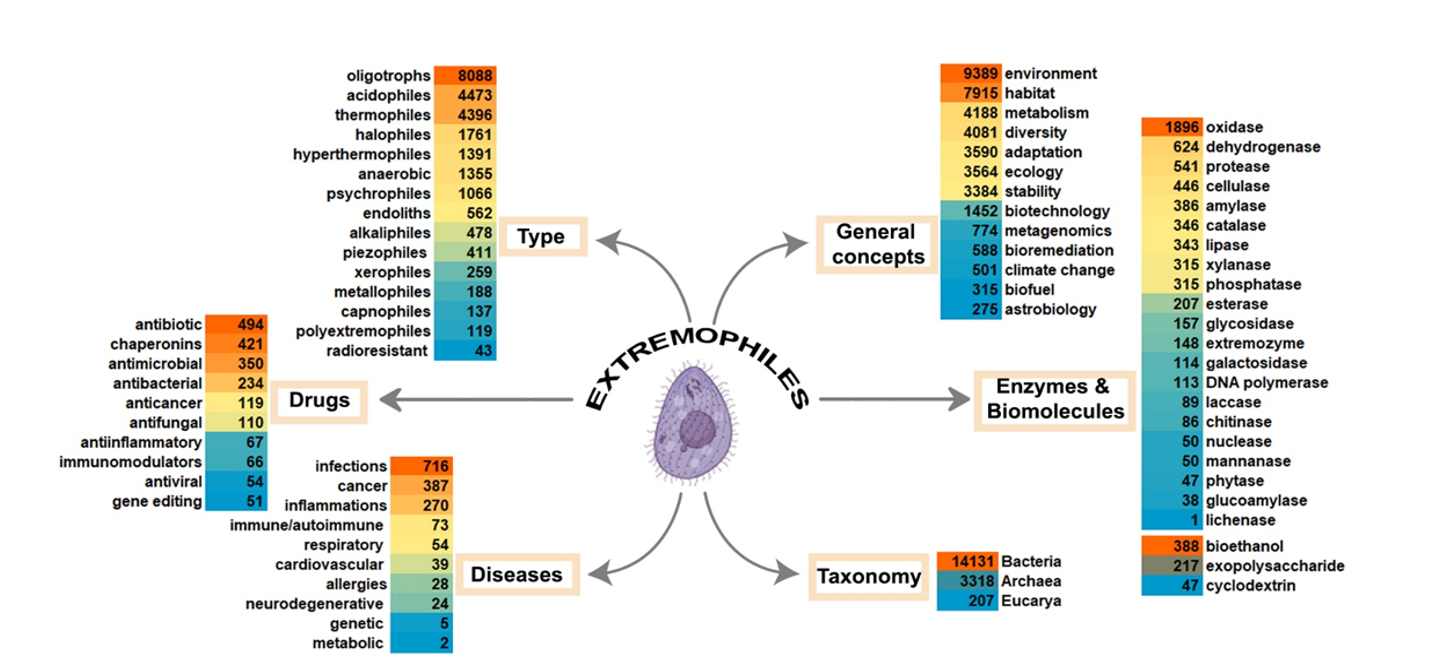
Biotechnological and industrial applications of extremophiles
Biomedical applications:
Extremophile-derived bioactive compounds and enzymes are revolutionizing the pharmaceutical and biomedical industries due to their stability and novel mechanisms. They’ve already been critical to the development of CRISPR-Cas9 technology, and while the famous Cas9 from Streptococcus pyogenes has limitations in stability, the heat-adapted Cas enzymes such as Thermus thermophilus Cas9 work at high temperatures. Enzymes from acidophiles also enable gene editing in acidic environments (e.g., gut microbiome engineering). Radiophiles like Deinococcus radiodurans offer novel DNA-repair templates to enhance CRISPR accuracy and reduce off-target effects.
Biomolecules and extremozymes are driving new discoveries in cardiovascular research. For example, fibrinolytic enzymes from thermophiles like Geobacillus can dissolve blood clots more efficiently than current thrombolytics with higher temperature stability and longer circulation time. Antioxidant proteins from radiophiles neutralize oxidative stress, a key driver of atherosclerosis and heart failure. Extremophile lipids also show promise in cardiovascular drug delivery. For example, heat-stable liposomes from thermophiles improve targeted drug delivery to atherosclerotic plaques, while cold-adapted membrane transporters from Antarctic microbes help drugs penetrate calcified arteries more effectively.
Extremozymes also target protein aggregates, making them potentially transformative for tackling neurodegenerative diseases including, Alzheimer’s, Parkinson’s, and ALS. Thermophilic proteases (e.g., from Thermus aquaticus) degrade amyloid-beta and tau fibrils more efficiently than human enzymes, resisting the brain’s oxidative environment. Cold-adapted chaperones prevent α-synuclein misfolding in Parkinson’s by maintaining protein stability at low concentrations. It has been reported that Pyrococcus furiosus protease reduces amyloid plaques by 70% in transgenic mouse models.
In addition to these biomedical applications, hyperthermophiles like Thermococcus gammatolerans have been found to produce polyketides with antibacterial and anticancer properties, targeting multidrug-resistant pathogens and cancer cell lines. Extremozymes are also used in drug synthesis and the development of sensors and diagnostic tools.
For example, cold-active enzymes from psychrophiles are being integrated into biosensors for detecting biomarkers in low-temperature clinical settings, such as glucose monitoring for diabetes. Halophilic proteins like bacteriorhodopsin from Halobacterium salinarum are used in light-activated diagnostic systems. These applications demonstrate extremophiles’ potential for revolutionizing many aspects of biomedicine.
Environmental applications:
Bioremediation, the use of microorganisms to degrade or detoxify environmental pollutants, is a growing use of extremophiles, particularly in extreme conditions where conventional microbes cannot survive.
- Hydrocarbon degradation: Psychrophiles like Alcanivorax borkumensis degrade oil spills in cold marine environments, such as Arctic waters, by metabolizing hydrocarbons into non-toxic compounds. Thermophiles, such as Geobacillus thermodenitrificans, treat oil-contaminated industrial effluents at high temperatures, improving cleanup efficiency.
- Heavy metal remediation: Acidophiles, including Acidithiobacillus ferrooxidans, extract heavy metals like copper and uranium from mining waste through bioleaching, reducing environmental toxicity. Halophiles from hypersaline lakes, such as Halomonas elongata, sequester metals like cadmium in saline industrial waste, restoring contaminated sites.
- Plastic and xenobiotic degradation: Recent discoveries highlight extremophiles’ ability to degrade synthetic pollutants. For instance, a 2024 study identified a psychrophilic Ideonella sakaiensis strain that produces cold-active PETases, enzymes that break down polyethylene terephthalate (PET) plastics in cold environments, offering sustainable solutions for plastic waste management.
Biofuel and renewable energy applications:
Extremophiles contribute to sustainable energy production by enabling efficient biofuel synthesis and biomass processing under extreme conditions.
- Bioethanol production: Thermophilic bacteria like Clostridium thermocellum produce cellulases that break down lignocellulosic biomass into fermentable sugars for bioethanol production. Their high-temperature activity reduces contamination risks and accelerates hydrolysis, lowering production costs.
- Biogas and hydrogen: Methanogenic archaea, such as Methanothermobacter thermautotrophicus, thrive in high-temperature anaerobic digesters, converting organic waste into methane for biogas. Piezophilic bacteria from deep-sea environments, like Shewanella benthica, are explored for biohydrogen production under high-pressure conditions, offering a clean energy alternative.
- Algal biofuels: Halophilic microalgae, such as Dunaliella salina, accumulate lipids in high-salinity conditions, which are processed into biodiesel. Their resilience to saline environments enables cultivation in non-arable land, preserving freshwater resources.
Food and beverage processing applications:
Extremophiles enhance food processing by providing enzymes that operate under the extreme conditions of industrial food production.
- Dairy and beverage processing: Psychrophilic proteases and lipases are used in cheese ripening and juice clarification, operating at low temperatures to preserve flavor and nutritional quality. For instance, Pseudoalteromonas enzymes improve milk protein hydrolysis in cold storage.
- Starch and sugar processing: Thermophilic amylases from Bacillus licheniformis hydrolyze starch in high-temperature processes for syrup production that is used in beverages and confectionery. These enzymes ensure high yields and reduce processing times.
- Fermentation: Halophilic enzymes from Halobacterium species facilitate saline fermentations, such as in fish sauce and soy sauce production, enhancing flavor profiles in high-salt conditions.
Agricultural applications:
Extremophiles contribute to sustainable agriculture through biopesticides, soil remediation, and plant growth enhancement.
- Biopesticides: Antifungal peptides from halophiles protect crops from pathogens like Fusarium and reduce chemical pesticide use. These peptides disrupt fungal membranes, thereby offering a targeted approach.
- Soil remediation: Acidophilic bacteria like Acidithiobacillus rioensis mobilize heavy metals in contaminated soils, restoring agricultural land. Their sulfur-based metabolism detoxifies mining-affected areas.
- Plant stress tolerance: Halophilic osmoprotectants, such as ectoine from Halomonas elongata, enhance plant resilience to salinity and drought, improving crop yields in arid regions. Field trials in 2025 showed increased wheat productivity in saline soils treated with ectoine.
Industrial material and processes:
Extremophiles are used in industries like textiles, leather, and cosmetics where their robust enzymes and compounds excel in harsh processing conditions.
- Textile processing: Alkaliphilic proteases from Bacillus alkalophilus remove protein-based stains and facilitate dyeing in alkaline conditions, improving textile quality and reducing water use.
- Leather tanning: Halophilic and alkaliphilic enzymes dehair and degrease hides in high-salt or high-pH tanning processes. They also replace toxic chemicals.
- Cosmetics: Ectoine and β-carotene from halophiles like Dunaliella salina are used in moisturizers and sunscreens, protecting skin from UV damage and dehydration due to their stability in high-salt formulations.
Future directions for extremophiles
Despite their promise, extremophiles face challenges in broadening their usage. Culturing fastidious organisms and the high cost of enzyme purification are two important hurdles, along with scaling up production. Metagenomics and synthetic biology are addressing these issues by enabling the expression of extremophile genes in tractable hosts like Escherichia coli.
Advances in high-throughput screening and AI-driven bioprospecting are also accelerating the discovery of new extremozymes and compounds. Integrating extremophile-derived technologies with nanotechnology and green chemistry could enhance their efficiency and applicability even further.
To fully capitalize on the potential benefits of extremophiles, researchers should focus on several key directions:
- Exploring underexamined extremes: Investigating lesser-studied extreme environments (e.g., deep subsurface, hyperarid deserts, and high-radiation zones) may reveal novel extremophiles with unprecedented adaptations.
- Mechanistic insights into survival strategies: Advanced genomic, proteomic, and metabolomic approaches should be employed to decipher the molecular mechanisms behind extremophile resilience.
- Synthetic biology and enzyme engineering: Leveraging extremophile-derived biomolecules through genetic modification and directed evolution could enhance their industrial applicability.
- Astrobiology and space missions: Extremophiles should be further studied as models for potential extraterrestrial life, particularly in Mars analogs and icy moons like Europa and Enceladus.
- Interdisciplinary collaborations: Combining microbiology, bioinformatics, materials science, and engineering will accelerate discoveries and applications.
As technology advances, extremophiles will continue to reshape our understanding of life’s adaptability and inspire solutions for some of our biggest challenges.
For more information, see our journal article, Extremophiles: Unlocking Bioactive Compounds and Biotechnological Innovation from Life at the Edge.

